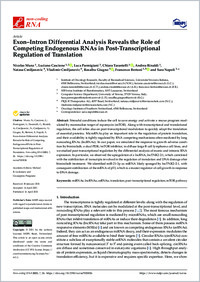Exon–Intron differential analysis reveals the role of competing endogenous RNAs in post-transcriptional regulation of translation
- Munz, Nicolas Institute of Oncology Research (IOR), Faculty of Biomedical Sciences, Università della Svizzera italiana, Switzerland
- Cascione, Luciano Institute of Oncology Research (IOR), Faculty of Biomedical Sciences, Università della Svizzera italiana, Switzerland - SIB Swiss Institute of Bioinformatics, Lausanne, Switzerland
- Parmigiani, Luca Computer Science Department, University of Verona, Verona, Italy
- Tarantelli, Chiara Institute of Oncology Research (IOR), Faculty of Biomedical Sciences, Università della Svizzera italiana, Switzerland
- Rinaldi, Andrea Institute of Oncology Research (IOR), Faculty of Biomedical Sciences, Università della Svizzera italiana, Switzerland
- Cmiljanovic, Natasa PIQUR Therapeutics AG, Basel, Switzerland
- Cmiljanovic, Vladimir PIQUR Therapeutics AG, Basel, Switzerland
- Giugno, Rosalba Computer Science Department, University of Verona, Verona, Italy
- Bertoni, Francesco Institute of Oncology Research (IOR), Faculty of Biomedical Sciences, Università della Svizzera italiana, Switzerland - Oncology Institute of Southern Switzerland, Bellinzona, Switzerland
- Napoli, Sara Institute of Oncology Research (IOR), Faculty of Biomedical Sciences, Università della Svizzera italiana, Switzerland
-
2021
Published in:
- Non-coding RNA. - MDPI. - 2021, vol. 7, no. 2, p. 13
English
Stressful conditions induce the cell to save energy and activate a rescue program modulated by mammalian target of rapamycin (mTOR). Along with transcriptional and translational regulation, the cell relies also on post-transcriptional modulation to quickly adapt the translation of essential proteins. MicroRNAs play an important role in the regulation of protein translation, and their availability is tightly regulated by RNA competing mechanisms often mediated by long noncoding RNAs (lncRNAs). In our paper, we simulated the response to growth adverse condition by bimiralisib, a dual PI3K/mTOR inhibitor, in diffuse large B cell lymphoma cell lines, and we studied post- transcriptional regulation by the differential analysis of exonic and intronic RNA expression. In particular, we observed the upregulation of a lncRNA, lncTNK2-2:1, which correlated with the stabilization of transcripts involved in the regulation of translation and DNA damage after bimiralisib treatment. We identified miR-21-3p as miRNA likely sponged by lncTNK2-2:1, with consequent stabilization of the mRNA of p53, which is a master regulator of cell growth in response to DNA damage.
- Language
-
- English
- Classification
- Biotechnology
- License
- Open access status
- gold
- Identifiers
-
- RERO DOC 333639
- DOI 10.3390/ncrna7020026
- ARK ark:/12658/srd1319196
- Persistent URL
- https://n2t.net/ark:/12658/srd1319196
Statistics
Document views: 186
File downloads:
- Texte intégral: 248
